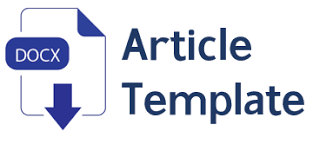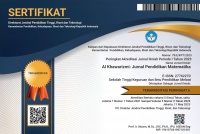KEMAMPUAN REPRESENTASI CALON GURU MATEMATIKA DALAM MENYELESAIKAN MASALAH GEOMETRI
Abstract
Abstrak: Penelitian ini bertujuan untuk mengetahui kemampuan representasi matematis mahasiswa calon guru dalam menyelesaikan masalah matematika. Karena peran guru menentukan kualitas pembelajaran, maka hasil penelitian ini diharapkan dapat memberikan gambaran kualitas calon guru ketika menyampaikan konsep di kelas. Selain itu, dapat memberikan wawasan kepada calon guru untuk lebih meningkatkan kemampuan representasi matematisnya melalui pengalaman dan latihan dalam menyelesaikan masalah matematika agar memiliki kemampuan representasi matematis yang baik. Metode yang digunakan adalah metode kualitatif. Subjek dalam penelitian ini adalah mahasiswa semester 7 Program Studi Pendidikan Matematika STKIP Melawi. Teknik yang digunakan untuk mengumpulkan data adalah dokumentasi. Data dianalisis melalui tahap reduksi data, penyajian data, menarik kesimpulan, dan verifikasi.
Kata Kunci: Kemampuan, Representasi, Geometri.
Abstract : This research aims to determine the mathematical representation abilities of prospective teacher students in solving mathematical problems. Because the teacher's role determines the quality of learning, it is hoped that the results of this research can provide an overview of the quality of prospective teachers when conveying concepts in the classroom. Apart from that, it can provide insight to prospective teachers to further improve their mathematical representation abilities through experience and practice in solving mathematical problems so that they have good mathematical representation abilities. The method used is a qualitative method. The subjects in this research were 7th semester students of the STKIP Melawi Mathematics Education Study Program. The technique used to collect data is documentation. Data was analyzed through the stages of data reduction, data presentation, drawing conclusions and verification.
Keywords: Ability, representation, geometry .
Full Text:
PDFReferences
Anderson, L.W., & Krathwohl, D.R. (2001). Kerangka landasan untuk
pembelajaran, pengajaran, dan asesmen (Terjemahan). Yogyakarta: Pustaka
Pelajar.
Astutik, S., & Prahani, B. K. (2018). The Practicality and Effectiveness of Collaborative Creativity Learning (CCL) Model by Using PhET Simulation to Increase Students' Scientific Creativity. International Journal of Instruction, 11(4), 409-424.
Eveline, E., & Suparno, S. (2021). Analisis Higher Order Thinking Skills (HOTS) Siswa Sekolah Menengah Atas di Kota Pontianak. QUANTUM: Jurnal Pembelajaran IPA dan Aplikasinya, 1(1).
Florida, Mellander, & King. (2015). The global creativity index. Retrieved from
http://martinprosperity.org/media/Global-Creativity-Index-2015.pdf
Hake, R. R. (1998). Interactive-engagement versus traditional methods: A six-thousand-student survey of mechanics test data for introductory physics courses. American journal of Physics, 66(1), 64-74..
Hattie, John. (2001). (Online).(http://visible-learning.org/hattie-rankinginfluences-effect-sizes-learning-achievement/, dikunjungi 8 Januari 2016)
Hayati, D. P., Bintari, S. H., & Sukaesih, S. (2018). Implementation of the practicum methods with guided-discovery model to the student skill of science process. Journal of Biology Education, 7(1), 118-126.
Indriana, D. (2011). Ragam alat bantu media pengajaran. Yogyakarta: DIVA Press.
K. Whiting. (2020, Oct. 2020). These are the top 10 job skills of tomorrow – and how long it takes to learn them [Online]. Available https://www.weforum.org/agenda/2020/10/top-10-work-skills-of-tomorrow-how-long-it-takes-to-learn-them/
Kementrian Pendidikan dan Kebudayaan. (2013), Gambaran Struktur Materi Pelatihan
Guru Implementasi Kurikulum 2013, Badan Pengembangan Sumber Daya
Manusia, Medan.
Kurniasari, R. T. A., & Koeshandayanto, S. (2020). Perbedaan Higher Order Thinking Skills pada Model Problem Based Learning dan Model Konvensional. Jurnal Pendidikan: Teori, Penelitian, Dan Pengembangan, 5(2), 170-174.
Lavine, R. (2012). Guided Discovery Learning. N. Seel (Ed.), Encyclopedia of the
sciences of learning. Boston, MA: Springer US.
Little, D. (1995). Learning as dialogue: The dependence of learner autonomy on
teacher autonomy. System, 23(2), 175-181, doi: 10.1016/0346-
X(95)00006-6.
Mardapi, D. (2012). Pengukuran penilaian & evaluasi pendidikan. Yogyakarta:
Nuha Medika.
Mulyaningsih, I. E. (2014). Pengaruh interaksi sosial keluarga, motivasi belajar,
dan kemandirian belajar terhadap prestasi belajar. Jurnal Pendidikan dan
Kebudayaan, 20(4), 441-451. doi: 10.24832/jpnk.v20i4.156.
Munadi, Y. (2013). Media pembelajaran (sebuah pendekatan baru). Jakarta: Referensi
(GP Press Group)
Permatasari, R. (2019). Korelasi antara hasil belajar dan metakognisi siswa sekolah dasar di nanga pinoh, kalimantan barat. At-Thullab: Jurnal Pendidikan Guru Madrasah Ibtidaiyah, 3(2), 45-51.
Prastowo, A. (2011). Panduan Kreatif Membuat Bahan Ajar Inovatif. Yogyakarta:
DIVA Press.
Rusyan, A., Kusdinar, A., dan Arifin, Z. (1989). Pendekatan dalam proses belajar
mengajar. Bandung: Remadja Karya.
Salame, I. I., & Makki, J. (2021). Examining the use of PhEt simulations on students’ attitudes and learning in general chemistry II. Interdisciplinary Journal of Environmental and Science Education, 17(4), e2247.
Schunk, D.H. (2012). Learning theory: An educational Perspective (6th ed.).
Boston: Pearson Education, Inc
Simamora, R. E., & Saragih, S. (2019). Improving Students' Mathematical Problem Solving Ability and Self-Efficacy through Guided Discovery Learning in Local Culture Context. International Electronic Journal of Mathematics Education, 14(1), 61-72.
Simamora, R. E., & Saragih, S. (2019). Improving Students' Mathematical Problem Solving Ability and Self-Efficacy through Guided Discovery Learning in Local Culture Context. International Electronic Journal of Mathematics Education, 14(1), 61-72.
Sugiyono. (2016). Metode penelitian kombinasi. Bandung: Alfabeta
Surya, Y. (2009). Getaran dan Gelombang. Tangerang: PT Kandel.
Tipler, P.A. (1991). Fisika untuk Sains dan Teknik Jilid 1. Jakarta: Erlangga
Wieman, C. E., Adams, W. K., & Perkins, K. K. (2008). PhET: Simulations that enhance learning. Science, 322(5902), 682-683.
Yilmaz, K. (2011). The cognitive perspective on learning: Its theoretical
underpinnings and implications for classroom practices. The Clearing House: A
Journal of Educational Strategies, Issues and Ideas, 84(5), 204-212.
https://doi.org/10.1080/00098655.2011.568989.
DOI: https://doi.org/10.46368/kjpm.v3i2.1514
Article Metrics
Abstract view : 29 timesPDF - 17 times
Copyright (c) 2023 AL KHAWARIZMI: Jurnal Pendidikan Matematika
Contact:
Jurnal Al-Khawarizmi email: jurnalalkhawarizmi2@gmail.com
STKIP Melawi Jl. RSUD Melawi Km. 04. Kec. Nanga Pinoh Kab. Melawi

This work is licensed under a Creative Commons Attribution-NonCommercial-ShareAlike 4.0 International License.



